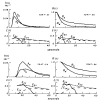Myocardial sodium extraction at varied coronary flows in the dog. Estimation of capillary permeability of residue and outflow detection
- PMID: 1098804
- PMCID: PMC2982781
- DOI: 10.1161/01.res.37.3.359
Myocardial sodium extraction at varied coronary flows in the dog. Estimation of capillary permeability of residue and outflow detection
Abstract
Sudden injections of boluses containing both 131I-albumin and 24NaCl were made into the coronary artery inflow of isolated blood-perfused dog hearts. Indicator dilution curves were recorded using gamma emissions from both the intact heart and the coronary sinus outflow, with plasma flows, Fs, ranging from 0.3 to 1.8 ml/g min-1. Three measures of sodium extraction, E, during transcapillary passage were obtained from each site by comparison of the sodium and albumin curves. The most useful estimates of E were "instantaneous extractions" obtained from the later part of the upslope and the peak of the venous dilution curves (coronary sinus) or from the corresponding early phase of washout of the externally monitored curves (intact organ). Extractions were lower at higher flows. Permeability-surface area products, PS, were computed (1) by the formula PS equals -Fsloge(1 - E), (2) by fitting the observed dilution curves with a Krogh capillary-tissue cylinder model, and (3) by the approximating formula PS equals -Fsloge (1 - 1.14E). The two latter approaches provided a correction for back diffusion of tracer from tissue to blood. For sodium, the values of PS averaged 0.88 +/- 0.36 (SD) ml/g min-1, (n equals 52). At high flows, with Fs greater than 1.0 ml/g min-1, the values of PS averaged 1.01 +/- 0.38 ml/g min-1 (N equals 11). Assuming S equals 500 cm2/g and plasma to be 93% water, our findings suggest capillary permeabilities for sodium of about 3.1 times 10(-5) cm/sec.
Figures









References
-
- Crone C. Permeability of capillaries in various organs as determined by use of the “indicator diffusion” method. Acta Physiol Scand. 1963;58:292–305. - PubMed
-
- Zierler KL. Theory of use of indicators to measure blood flow and extracellular volume and calculation of transcapillary movement of tracers. Circ Res. 1963;12:464–471.
-
- Lassen NA, Crone C. Extraction fraction of a capillary bed to hydrophilic molecules: Theoretical considerations regarding the single injection technique with a discussion of the role of diffusion between laminar streams (Taylor's effect) In: Crone C, Lassen NA, editors. Capillary Permeability. Copenhagen; Munksgaard: 1970. pp. 48–59.
-
- Yudilevich DL, Martin de Julián P. Potassium, sodium, and iodide transcapillary exchange in dog heart. Am J Physiol. 1965;208:959–967. - PubMed
Publication types
MeSH terms
Substances
Grants and funding
LinkOut - more resources
Full Text Sources
Miscellaneous

